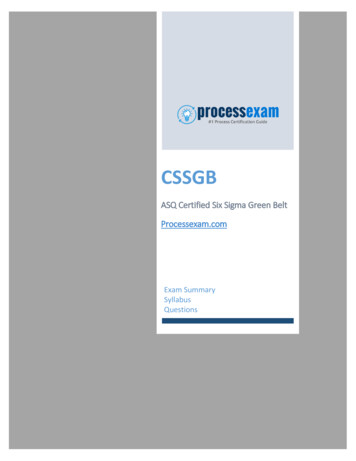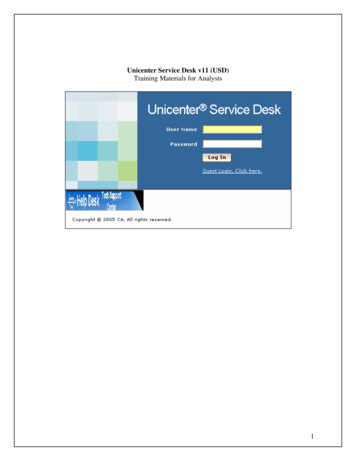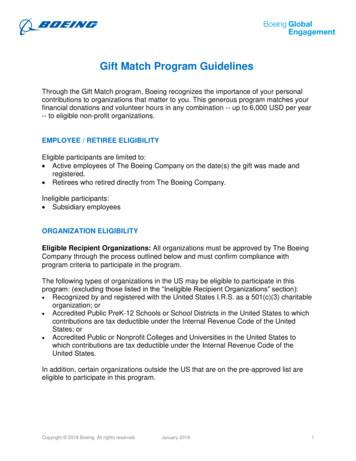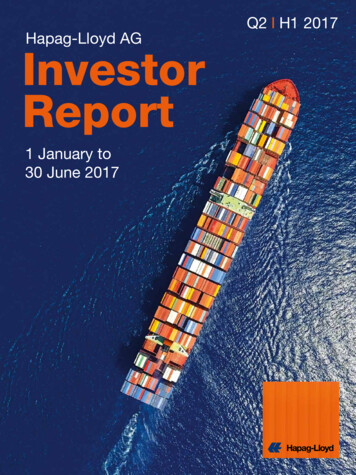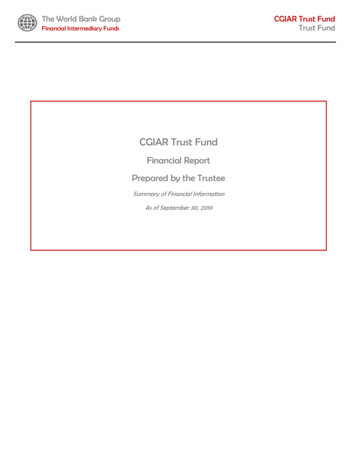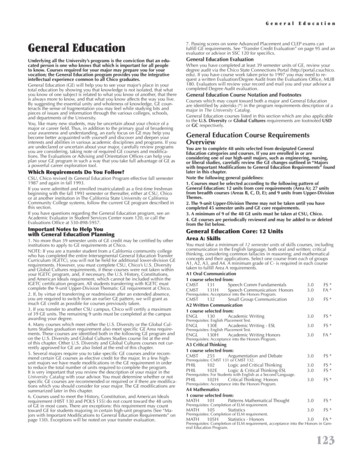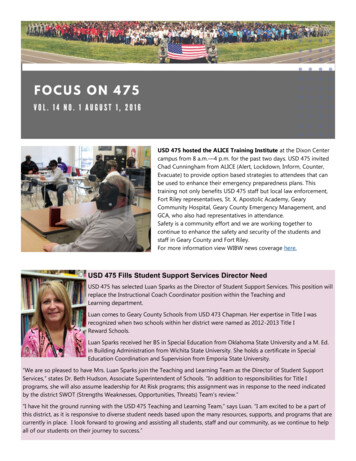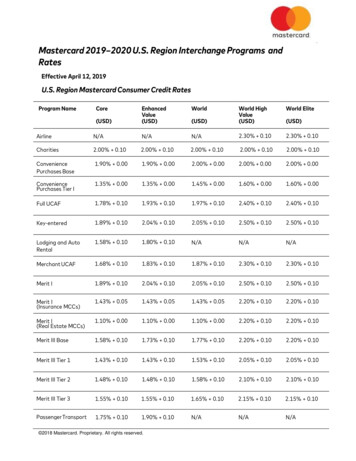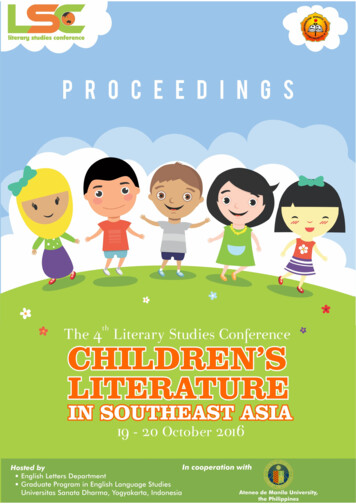
Transcription
Proceedings “Children’s Literature in Southeast Asia” ISBN 978-602-60295-0-8PROCEEDINGSThe 4th Literary Studies Conference“Children’s Literature in Southeast Asia”Advisory BoardDr. Fr. B. Alip, M.Pd., M.A., Sri Mulyani, Ph.D., Th. Enny Anggraini, Ph.D.(English Letters Department, Universitas Sanata Dharma, Indonesia)Paulus Sarwoto, Ph.D.(Graduate Program in English Language Studies, Universitas Sanata Dharma, Indonesia)Dr. Murti Bunanta, S.S., M.A.(President of Society for the Advancement of Children’s Literature/Indonesian Board on Books for Young People, Indonesia)Prof. Carla M. Pacis(Department of Literature, De La Salle University, Philippines)Assoc. Prof. Amporn Sa-ngiamwibool, Ph.D.(English Department, Shinawatra University, Thailand)Ivan Stefano, Ph.D.(Department of Education, Ohio Dominican University, United States)with an Introduction byAssoc. Prof. Amporn Sa-ngiamwibool, Ph.D.(Shinawatra University)EditorsElisabeth Oseanita PukanHarris Hermansyah SetiajidHosted by English Letters Department Graduate Program in English Language StudiesUniversitas Sanata Dharma, Yogyakarta, Indonesiain cooperation withAteneo de Manila University, PhilippinesUniversitas Sanata Dharma, Yogyakarta, Indonesia2016The 4t hLiterary Studies Conference2 0 1 6 i
Proceedings “Children’s Literature in Southeast Asia” ISBN 978-602-60295-0-8Proceedings“Children’s Literature in Southeast Asia ”Copyright 2016Literary Studies ConferenceUniversitas Sanata Dharma, Yogyakarta, IndonesiaPublished byEnglish Letters Department, Faculty of Letters,Universitas Sanata DharmaJl. Affandi, Mrican Yogyakarta 55281Telp. (0274) 513301, 515253EditorsElisabeth Oseanita PukanHarris Hermansyah SetiajidCover DesignerDina FebriyaniFirst published 2016212 pages; 294 x 201 mmISBN 978-602-60295-0-8All rights reserved.No part of this publication may be reproduced, stored in a retrieval system, transmitted in anyform, or by any means, electronic, mechanical, photocopying, recording, or otherwise, withoutthe prior written permission of the publisher.ii T h e4t hLiteraryStudies Conference 2016
Proceedings “Children’s Literature in Southeast Asia” ISBN 978-602-60295-0-8ContentsTitle .iCopyright. iiContents . iiiA Welcoming Address, Rector of Universitas Sanata Dharma . vA Welcoming Note from the Conference Chair . viIntroductionAmporn Sa-ngiamwibool . 1Indonesian Children’s Literature - A Journey of Discovery for ResearchersMurti Bunanta . 4The #WeNeedDiverseBooks Movement: What it is and why it MattersLinda Parsons . 8The Role of Young-Adults Fiction in Maintaining the Notion of Romantic Love and SexJeremy Christian Sombowadile .15Native Americans Identity: N. Scott Momaday’s Political Strategy of ‘Orality and Literacy’Ade Maria Partiani and Lestari Manggong .18Anticipating the Nation: National Narratives of Change in the Fiction of Pramoedya Anata Toer andRene O. VillanuevaAmado Anthony G. Mendoza III .22Young Adult Heroism in the Buru QuartetAmalia Ayu Wardhany .28Analisis Teknik, Metode dan Ideologi pada Penerjemahan Cerpen AnakArini Noor Izzati .33Dr. Seuss, Theater and Alternative LiteracyArmelia Safira, Ni Luh Putu Sriwardani, Ari J. Adipurwawidjana, Lestari Manggong, SandyaMaulana .43Promoting Children Literature to Foster Language AwarenessAtikah Ruslianti and Rahayu Purbasari .47Feminist Perspective in Barbara G. Walker’s Feminist Fairy TalesBitha Cahya Romansha .50Adapting Indonesian Local Value in Literature for Children and Young Adult (LCYA) as A Form ofPeace Education to Prevent Violence and Bullying Among Children and YouthBunga Astya Syafitri .53Close Reading of Selected Titles about Indigenous ChildrenChina Pearl Patria M. De Vera .59The Study of Adjective Clause to Assist Children’s Imagination in Reading Antoinne de Saint Exupery’s The Little PrinceChindy Christine and Franssisca Xaveria .66Finding the Lost Child: Toward an Alternative Historization and Value of Children’s LiteratureChristian Jil R. Benitez .73The 4t hLiterary Studies Conference2 0 1 6 iii
Proceedings “Children’s Literature in Southeast Asia” ISBN 978-602-60295-0-8From Playground to the Battleground: A Comparative Analysis of Battle of Surabaya and Kangkong1896Christian Lemuel M. Magaling . 82Student’s Perception on Power Relation in Simple Plan’s Song Entitled Perfect (A Critical DiscourseAnalysis)Christianti Tri Hapsari, Femy Seniwegiasari, and Nur Alviyanti Fauzi . 90An Analysis of the Biography for Young Readers as Literary History through the Great Lives Seriesby Tahanan BooksFrancis Eduard L. Ang. 95How Dominican Girls Lost Their Freedom in Julia Alvarez’s Before We were Free and How theGarcia Girls Lost Their AccentsFitri Novianti .108The Child, Power, and Reimagination in Gremer Chan Reyes’ Short FictionHannah Marie R. Aranas .111Social Agenda in Children’s Stories in the Bisaya 1982-1984Hope Sabanpan-Yu .117Literacy on Health and Environment in Eight Novels Written by Indonesian ChildrenIda Farida Sachmadi .126Rewriting Folktales: Children Literature Context, Adaptation, and Pedagogical Aspects: Europeanand Madura TalesImron W. Harits.130Learning From Their Own BookHeronimus Adityo, Hilaria Kurniati Meot and Ferdinandus Heryanto Dala .135Sowing Seeds: Phyto-criticism and the Botanical Dimensions of Indonesian Literature for Childrenand Young Adults (LCYA)John Charles Ryan.140Naturalness Issue in a Series of Indonesian Islamic Children Literature TranslationLaily Martin .147Students’ Perspective on Ecological Issues in Krishan’s “A Voice of Tree”Mia Fitria Agustina, T ribuana Sari, Dian Adiarti .154Retelling Oral Literature by and for Indigenous Groups: The Case of the Blaan, Tagakaolo, andTboliM.J. Cagumbay Tumamac (Xi Zuq) .158“We Can Do It! –or Can We?”: Subjectivity in Indonesian Films for ChildrenNia Nafisah .163Significant Roles of Adult Readers in Deconstructing the Ideology in Eddy Supangkat’s “SeriPetualangan Kancil”Pramesthi Dewi Kusumaningrum and Palupi Sulistyomurni .173Cinderellas in Indonesia: Story Variants of Indonesian Folktales with the Theme of ‘Kind and UnkindGirls’Qanitah Masykuroh.176Teenage Dream: Fantasy as a Tool for Writing Diversity in Literature for Young AdultsRayjinar Salcedo.180iv T h e4t hLiterary Studies Conference2016
Proceedings “Children’s Literature in Southeast Asia” ISBN 978-602-60295-0-8Local Wisdom in Literature Activities for ChildrenRini Lindawati . 185The Use of Puppet Performances in Delivering Positive Values to Young Children: A Case Study ofAlden Puppet Ministry, GPdI Kopo Permai BandungRizki Theodorus Johan and Darell Reinhard . 188Higher Order Thinking (Hot) in Storytelling: An Innovative Learning Model to Improve SpeakingSkill of Grade Seventh Students in BandungSri Setyarini . 196Returning to the Past, Correcting the Past, and Rewriting the Past in Young Adult Novels Prada andPrejudice and Roro Mendut in LoveTri Pramesti and Adeline Grace M. . 199The Effect of Disney Movie in Creating Children Stereotype as Reflected in the Little Mermaid(1989) MovieUswatun Hasanah and Cindy Kurnia Octaviyanti . 204The Importance of Rewriting Papua’s Folktales for ChildrenWigati Yektiningtyas-Modouw and Precilia Rafra . 208Gambaran Pemahaman Mahasiswa terhadap Topik-topik Diskusi Sastra Anak dalam Pembelajarandi Kelas SastraYan Ardian Subhan. 213Developing Character Building Model for Children Based on Local Wisdom Using Applications ofDigital Fairy TaleYeni Probowati . 221Character Building and English Language Learning through Ivilo Edugame (Indonesian VisualFolklore Educational Game) to Increase Nation’s CompetitivenessYoga Adityatama and Mohamad Ikhwan Rosyidi . 224The Presence of Adult Characters in Enid Blyton’s The Six Bad BoysZidnie Ilma . 230Robinson Crusoe and the Modernization of Nineteenth-Century Sundanese Young PeopleAri J. Adipurwawidjana and Indra Sarathan . 235Languaging Child Empowerment in Stories of Departure: A Multimodal Discourse Analysis ofSelected Palanca-Winning Short Stories for Children In EnglishCheeno Marlo M. Sayuno . 243Of People and Nature: Eco Education in Young Adult Literature from AsiaNovita Dewi . 254(Re)Seeing Shadows: Eyes, Mirrors, and Education in Three Work of Ray BradburyIrfan Reza Hardiansyah and Sandya Maulana . 260Teaching Reading through Children’s Literature: The Impact and Process of Save the Children’sLiteracy Boost ProgramSierra Mae Paraan . 268Myth to Build Imagination: Short Remarks on Children’s LiteratureGabriel Fajar S.A. . 227Rene O. Villanueva, the Father of Modern Children’s Literature in the PhilippinesEliezar L. Inigo . 281The 4t hLiterary Studies Conference2 0 1 6 v
Proceedings “Children’s Literature in Southeast Asia” ISBN 978-602-60295-0-8A Welcoming AddressRector of Universitas Sanata DharmaI feel honored to welcome all speakers and participants of this conference to UniversitasSanata Dharma (USD). I also would like to extend my warmest regards to all of you. Letus ask for God’s blessings upon this encounter so it can be an effective means tostrengthen our roles as literature lecturers or researchers. I do hope that the conferencefacilitates a fruitful sharing and exchange of ideas to respond to the challenges ofchildren’s literature education in today's more connected world.This year USD is celebrating its 61 th anniversary. Responding to the challenges ofthe unavoidable emergence of our informational society, USD raises a theme for itsanniversary focusing on how to live smart, while conserving and enhancing humanisticvalues. The theme was selected as USD is fully aware of the huge potential of the growinginformational society for education. On the other hand, however, we are fully wary of itspossible threats to humanity itself.Such an informational society provides some new tools, approaches, theories, andparadigms on how to learn, socialize, work, do business and actualize ourselves. It alsocreates flexibility for it allows us to enjoy more relaxing time and freedom of spatialconstraints. It continually changes and expands our worldviews that the world is just likeour village where everyone knows what is going on in its corners. Therefore, in general itchanges how our children, who are native of this society, learn and master knowledge.Their capability to seek, search, filter, and put meanings on their literature is almostunlimited.USD appreciates and supports this conference especially when it takes its themeon children’s literature in Southeast Asia for at least two reasons. First, the emergenceof informational society brings imminent threats, in the form of swallow understandingas opposed to a deeper one. Thorough reading, which requires high discipline, isconsidered as not relevant any longer for most knowledge, which is visually represented.Second, stopping the influence of informational society is almost impossible. It requiresour creativity and willingness to search the more contextual approaches and paradigmsin promoting literature as an essential endeavor for shaping our children up.Finally, I do hope that the conference becomes a good event not only to promotehow important research on children’s literature is, but also to facilitate a fruitful dialoguein which sharing knowledge, values and awareness on the role of literature takes placewith joy and respect to each other. It is through such an orientation that we canproactively contribute to shape up our informational society better. As communication isa key to better understanding others, literature is a key to a better connected world. Maythe conference be successful and enjoyable, for God Almighty always blesses all our goodefforts.Thank you.Johanes Eka Priyatma, Ph.D.vi T h e4t hLiterary Studies Conference2016
Proceedings “Children’s Literature in Southeast Asia” ISBN 978-602-60295-0-8A Welcoming Note from the Conference ChairDear All,This year our conference, The 4 th Literary Studies Conference (LSC), bringschildren’s literature as the focus to discuss. Like the previous conferences, we regionallypay attention to Asia, more specific to Southeast Asia, since it aims to build networkamong universities and scholars in the region as well. In fact this topic leads all of us intothe awareness and reflection that the role and the position of children in our civilizationare absolutely significant. The era of children is critical due to the future our civilization;therefore, to provide a special arena for them means that we prove our big concern forthe future of our own lives. Certainly, by this perspective we do not split the two differentworlds and create a distinctive gap between the children world and the mature-peopleworld. The paradigm is that the children world is an important step to define the nextworld which identifies the qualities of human civilization in the next decade. Now thetime is here, and we all are invited to contribute to our bright future since it is in ourown hands.Thanks to God and to all of you, the presenters and participants. There are manyresponses coming from various places, such as the Philippines, Myanmar, South Korea,United States of America, and also Indonesia, to suggest good notions for the sake of ourfuture civilization. Many papers, covering articles and researches, complete theseproceedings, and all are highly qualified to present any notions and ideas dealing withour respect to the children’s significance against our context of living. We are reallyhappy that there are so many problems and interesting issues that could be uplifted dueto the condition of the literatures for children and young adults (LCYA). Not only are theacademicians here, in this conference, but also those practitioners are present to discuss.We are certain that this conference would give new insights for all of us, especially inconducting our ideal paradigm that literature for children and young adults is prominentto build a good myth for human civilization.As for your information, next year our conference’s topic will be about theexistence of migrants in coloring our world of literature. Thank you and enjoy theconference.Dr. Gabriel Fajar Sasmita Aji, M.Hum.The 4t hLiterary Studies Conference2 0 1 6 vii
Proceedings “Children’s Literature in Southeast Asia” ISBN 978-602-60295-0-8IntroductionLiterature for children and young adults (LCYA) is not the main focus in literary studies in Southeast Asia,including Indonesia, but LCYA is of great importance to us because children and young adults are our future.The contributions of LCYA are multifold. Here are some of the contributions. Above all, literature isthe source of knowledge on various subjects. Developing the habit of reading literature regularly from anearly age will enable children to cope with the rigors of academic edu cation later on more efficiently becauseeverything that they learn at this age will stay in their mind for a long run.In addition, reading literature regularly accelerates their ability to new words, expand the scope oftheir vocabulary learning and foster ways of using the words that they already know. All these enhance waysof learning and enable them to learn faster and better at school. Regular reading of LCYA helps them becomebetter language learners.M oreover, reading LCYA regularly stimulates children’s natural curiosity, the engine of intellectualachievement. Reading stories drives children to keep learning, keep trying, keep pushing forward – it’s thebasis of lifelong learning. Curiosity is a potent motivator to imagination. By reading the stories, childrenquickly learn to visualize the scenarios in the stories and impel them to move forward until they find theinformation that will fill in the gap in their imagination.As LCYA offers insights into different lifestyles, the insights are th e engines of soft skills which willdevelop them to be perfect adults who can solve life problems by relating the incidents in the stories to realevents in their lives. M ost importantly, the insights help accelerate their emotional development in the longrun.Last but not least, LCYA nurtures the mind. Literature creates empathy toward other peoplebecause it values humanity and celebrates human spirit and potential, offers insight into different but specificlifestyles while recognizing universality. It is helps develop children to become perfect humans. LCYA is,therefore, vital for human development.Considering the contributions of LCYA, this 4 th Literary Studies Conference (LSC) on the theme ofChildren Literature in Southeast Asia is a flagship of a true success which aims for human perfection. Thetheme includes all areas that are vital for children’s intellectual and emotional development in the long run,including: diversity in LCYA, language in LCYA, LCYA and language teaching, LCYA and translation, LCYA andoral tradition, LCYA and performance studies, the questions of authorship and readership in literature forchildren and young adults, LCYA and post-colonial imagination, LCYA and ecology, LCYA and psychology, andpeace education through LCYA.With regard to intellectual development, numerous studies deal with a wide variety of academicdisciplines that involve around local, universal, individual and collective topics. On local wisdom, oraltradition, folktales and cultural heritage and values are the topics in these studies: “Local Wisdom inLiterature Activities for Children,” “Indonesian Folktales for Thematic Teaching at Elementary School inIndonesia: A Literature Review,” “Rewriting Folktales: Children Literature Context, Adaptation , andPedagogical,” “Unmasking the Real Villain: Philippine National Identity as Represented in the SuperheroGraphic Literature Captain Barbell,” “ Learning From Their Own Book,” “Cinderellas in Indonesia: StoryVariants of Indonesian Folktales with the Theme of 'Kind and Unkind Girls',” and “Values in IndonesianChildren's Literature.”On universal wisdom, an increased interest in ecological questions across many academic disciplines has givenrise to ecocriticism, a thriving and contentious academic fie ld within literary studies. The studies that weredevoted to this global issue includes the following: “Of Place and Nature: Eco Literacy in Young AdultLiterature from Asia,” “Diving into Children’s Literature: A comparative analysis of children’s liter ature fromIndonesia, Philippines, and M alaysia and their representation of marine biodiversity issue,” “Students’Perspective on Ecological Issues In Krishan's "A Voice Of Tree,"” “Naturalness Issue in a Series of IndonesianIslamic Children Literature,” “Literacy on Health and Environment in Eight Novels Written by IndonesianChildren).”On individual issues, the studies deal with issues such as psychology (e.g. “Dr. Seuss, Theatre, andAlternative Literacy,” “Children's Autonomy in Enid Blyton's The Naughtiest Girl Again,” and “The Death ofWitches: Dark Humor in British Contemporary Children's Literary Works”), religion (e.g. “Catholic's Views onEvil as Seen in Tolkien's Trilogy The Lord of The Rings”) and society and cultures (e.g. “Social Agenda inChildren's Stories,” “Contemporary Theater of Cruelty: British Plays for Young People” and “Children'sLiterature for Children in M ulticultural Society”).Among all individual issues in this LCYA, gender study is a hot one. Several of the majormethodologies adopted in gender studies were inspired by feminist criticism focusing on gender politics (e.g.“Feminist Perspective in Barbara G. Walker’s Feminist Fairy Tales), identity and representation (e.g. “GenderThe 4t hLiterary Studies Conference2016 1
Proceedings “Children’s Literature in Southeast Asia” ISBN 978-602-60295-0-8Representation as Cultural Identity in Indonesia Children Literature”), power of eroticism (e.g.“The Roleof Young-Adults Fiction in M aintaining the Notion of Romantic Love and Sex”) and ecofeminism (e.g. “TheCalling of the Sea: An Ecofeminist Analysis of Contemporary Themes in Young Adult Novels in thePhilippines”). On the other hand, several studies were specifically dedicated to the study of feminine identitythrough an interdisciplinary approach and the intersection of gender with other categories of identity. Thesecategories include ideology (e.g. “Young Adult Heroism in The Buru Quartet”), ethnicity (“Javanese's WomenDepiction in Deryn M ansell's Tiger Stone”), sexuality (e.g. “Homotextuality in the Rainbow Boys Trilogy byAlex Sanchez”), sexual abuse (e.g. “Reading Child Sexual Abuse Theme s in American Young Adult Fiction toExplain How It M atters to Indonesians”), class (e.g. “Women's Space in Children's Literature”), nationality(e.g. “Anticipating the Nation: National Narratives of Change in the Fiction of Pramoedya Ananta Toer andRene O. Villanueva”) and religion (e.g. “ Destabilizing the Alterity of the M uslim Woman/Girl through IslamicFeminist Reading of I am M alaka (2013)” ).The most important contribution of the studies among individual issues in this LCYA might be that oflanguage learning. Literature is the most effective source of language learning and skill development.Therefore, several studies were devoted to reading improvement (e.g. “Logotherapeutic Reading of JaneEyre's Quest for Children's Freedom of Will,” “Teaching Reading through Children's Literature: The Impactand Process of Save the Children's Literacy Boost Program,” and “Reading through Complex Literature:Perspectives of Filipino and Indonesian Teachers in Reading Literature with Diverse and Sensitive Themes toPre-School and Elementary Students”), writing skill practice and improvement (e.g. “Teenage Dream: TheFantastic as a Tool for Writing”), translation(e.g. “Translation Technique Analysis on UtterencesEmbodying Implicatures Found in the Subtitles of a M ovie for Children and for Young Adults”), languageawareness-raising (e.g. “Promoting Children Literature to Foster Language Awareness”) and languageempowerment ( e.g. “Languaging Child Empowerment in Stories of Departure: A M ultimodal Discourse Analy sisof Selected Palanca-Winning Philippine Short Stories for Children in English”).With regard to emotional and mental development, the studies provide vital basis of life skills,thinking skills and soft skills. On life skills, some studies deal with a wide variety of experience to enrichchildren’s experience (e.g. “Student's Perception on Power Relation in Simple Plan's Song Entitled Perfect,”“The Child, Power, and Reimagination in Gremer Chan Reyes' Short Fiction Diversity” and “The SignificantRole of Readers in Reconstructing the Ideology in Eddy Supangkat's "Seri Petualangan Kancil"”) and widentheir restricted views (e.g. “Rene O. Villanueva, the Father of M odern Children's Literature in the Philippines,State of Young Adult Literature in the Philippines”).Other studies on life skills deal with thinking skills, some of which incorporated media literacy - theskills which are needed for life in the modern world. The studies regarding thinking skills include: “It's tooshort and simple!,” “Critical Reading of Children's Literature in Teacher Education Classroom,” “Higher OrderThinking (HOT) in Storytelling: An Innovative Learning M odel to Improve Speaking Skill of Grade SeventhStudents in Bandung,” and “Using Visual Literature in Enhancing Ch ildren's Narrative Creativity and M easuringCaregiver's Communicative Competence,” “Corpus Software Development for Students to Facilitate EnglishLearning for Elementary Level,” “Teaching Children Literature by Using M obile Device as One of TheirFavorites,” “The Effect of Disney M ovie in Creating Children Stereotype as Reflected in The Little M ermaid(1989) M ovie,” and “We Can Do It! - or Can We?" Subjectivity in Indonesian Films for Children.”A major concern in several studies focuses on soft skills which are an integral component foremotional and mental developments in the long run. Some studies were primarily devoted for attitudedevelopment (e.g. “Determining Factors influencing Grade Ten Students' Attitude towards Literature”) andcharacter building (e.g. “Character Building and English Language Learning Through Ivilo Edugame,”“Indonesian Visual Folklore Educational Game,” and “Developing Character Building Model for Children Basedon Local Wisdom Using Applications of Digital Fairy Tale to Incr ease Nation's Competitiveness”).The majority of studies, which were devoted to soft skills, aimed at peace education with anintention to foster an understanding of how peace education for children can work as part of a broaderconflict transformation process in the transformative approach. These studies involved around these sub topics: peace and conflict resolution (e.g. “Adapting Indonesian Local Value in Literature for Children andYoung Adult (LCYA) as A Form of Peace Education to Prevent Violence and Bullying Among Children andYouth), a cultivation of positive values (e.g. “The Use of Puppet Performances in Delivering Positive Valuesto Young Children: A Case Study of Alden Puppet M inistry”) and regional peace (e.g. “South East Asian StoryTelling & Early Childhood Education).One of the strategies to educate peace to children is to give a life lesson of conflicts in the past.Studies on post-colonial literature here involve around the effects of colonialism on cultures and societiesplay a vital role in peace education, especially in the colonized regions. The studies included the following:“Negotiating Native Americans Identity: N. Scott M omaday’s Political Strategy of 'Orality and Literacy,'”2 The4t hLiterary Studies Conference2016
Proceedings “Children’s Literature in Southeast Asia” ISBN 978-602-60295-0-8“Three Works of Stephen King as Coming-of-Age Novel,” “Sanctifying the Secular: Appropriating young adultfantasy as Catholic all
How Dominican Girls Lost Their Freedom in Julia Alvarez's Before We were Free and How the Garcia Girls Lost Their Accents . informational society for education. On the other hand, however, we are fully wary of its possible threats to humanity itself. Such an informational society provides some new tools, approaches, theories, and

